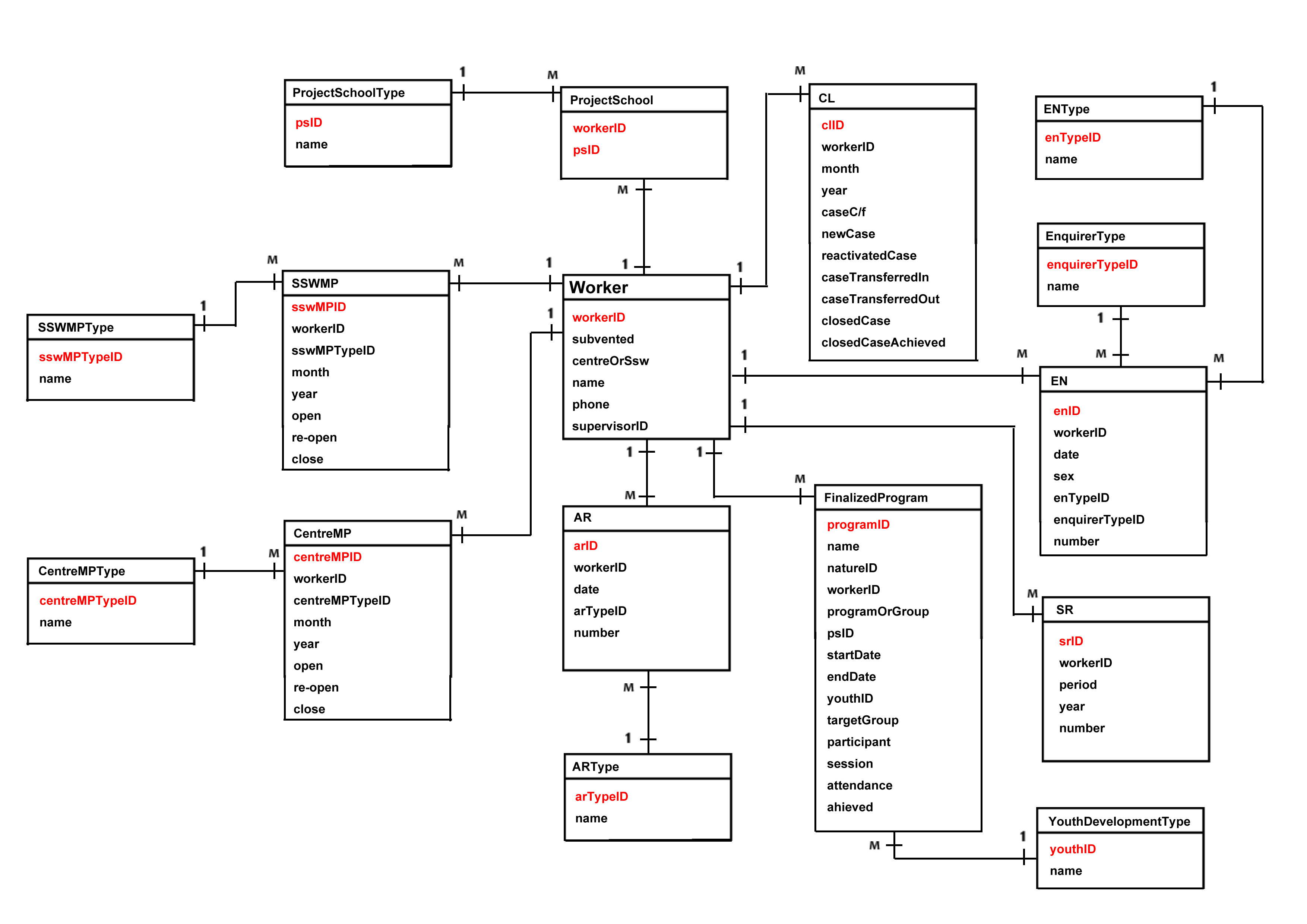Background
Case Statistics
Target Users
School social workers and administrative staff in centres
Target Locations
St. James' Settlement Centres and school
Current Situation
¡´ General Clarifications
- Assume all workers are social workers.
- Fields with code (e.g. AR1) in the spreadsheets are fields that will put in the reports.
- Except fields that are crossed out, all fields should be stored in the database.
- Short term: NS = Non-subvented.
- School Social Worker works for independent school. Other social workers who are not classified as 'School Social Workers' may also work for schools. We only need to classify the workers into 'social workers who work for independent school' and 'social worker who does not work for independent school'. The requirement and counting for these two types of social worker are different.
- Old data can be ignored and doesn¡¦t require saving into the database.
- Some important attributes of Social Worker entity that are specified by the client:
- Subvented (True / False)
- Centre that the social worker belongs to
¡´ Input Source (original spreadsheets) Clarifications
There are totally 10 spreadsheets in their current workflow. We will introduce them one by one.
-
Activities Recording Form (AR form)
- Each form is filled per month and per social worker.
- Input by social workers.
- AR1 fields marked in the AR form are part of the information needed in the J2 Report. J2 Report is a report for the Social Welfare Department. The database of the system should store all the fields in the AR form including the first 4 fields.
- Do not need an extra field to store the total number of activities since we can calculate it by other fields.
-
Enquiry Input Data Form for Youth Services (EN form)
- Each form is filled per month and per social worker.
- Input by social workers.
- Each entry of this form should include: Date, Sex, Type of Enquirers (may have 'others'), Type of Enquiry (may have 'others'), Name of Enquirers (optional).
- If the same person enquires more than once or different things in a day, it will count as multiple entries.
- One enquiry per entry/ row
-
Quarterly Record of Service Recipients Served per Worker (SR form)
- Each form is filled per quarter [Apr-Jun / Jul-Sept / Oct-Dec / Jan-Mar] and per social worker.
- Input by social workers.
- The database should store the total number of SR only but not the details.
- Possible ways to input 'Name of Worker' (suggested by the client):
- use login authentication (login automatically since they have logged in the computer)
- choose user from drop down list
-
Youth Services - Caseload (CL form) & Caseload and Activities Recording for School Social Work (SSWCL form)
- Each form is filled per month and per centre/independent school.
- Each entry in the database should be filled per social worker.
- Input by clerk in centre.
- Combine 2 forms CL and SSW-CL together.
- The short terms under the name of the worker in the form represent the school or project that the worker is working on.
Circled short term in CBIT-CL form represents school that is not independent school. Non-circled one is short term for project. - Relationship between social worker and school/project: one to many
The database should have an entity for school/project and is linked to the entity of social worker - No. of Closed Cases (CL1) and No. of Closed Cases achieved goal (CL2) are counted per quarter in J2.
However, we should record the numbers per month and calculate the numbers per quarter afterwards.
-
CBIT Nature of Main Problem of Cases (CBIT-MP) & SSW Nature of Main Problem of Cases(SSW-MP)
- Each form is filled per month and per social worker.
- Input by clerk in centre.
- Two separated forms for Centre Social Worker (CBIT-MP) and School Social Worker (SSW-MP)
- Drug problems should be counted separately. E1 has a field which only counts drug problems. The number of social norm problems should exclude the drug problems.
-
Program and Group (PG form)
- Each form is filled per month and per all social workers.
- Input by clerk in centre.
- This form summarizes the finalized P&G Activities.
- One program per entry.
- Meaning of the fields:
- No.: dummy field for counting
- Staff: name of person in charge
- Program/Group: select program or group
- School: name of school (can be null)
- Code: program code, Name: name of the program
- Date/Period: Start Date and End Date
- Nature: "©Ê½è" in P&G form choice 1-5 and SSW code
- Youth Development: "©Ê½è" in P&G form choice A-D (can be null)
- The database should store whether the activity is related to drugs/parenting-skills/NA or not.
This field should be flexible for adding new type. (need an entity for the types) - No. of attendance for one program: For example, if a program has 10 sessions and a participant has attended 7 sessions,
it will count as 7 for attendance. (Sum up all the number of attendance of the participants of that program)
-
Optional Features (order by priority)
- Program and Group form (P&G form)
- Import spreadsheets into the system
- Auto login (track the authentication of window login)
- Compensation leave and Overtime form
